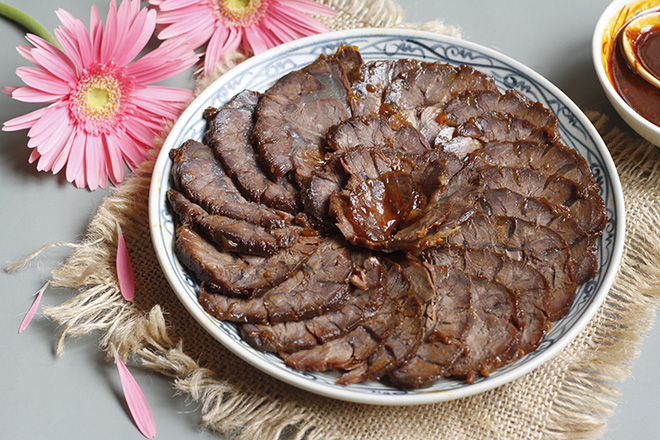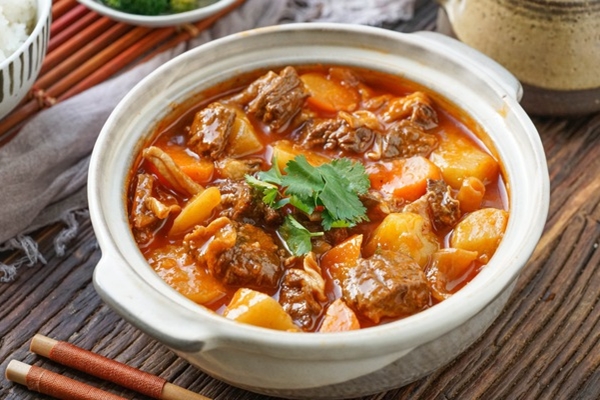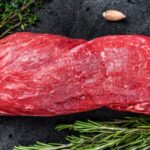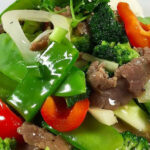Short ribs: Short ribs are taken from the belly of the cow and feature a marbling of fat and meat. They are tender and versatile, perfect for grilling, stir-frying, or hot pot. If the short ribs include cartilage, they are ideal for braising, resulting in a dish loved by many.
Shin/shank: The meat from the shin or shank area is also known as the leg of beef. It is divided into two parts: the front and rear shank. The smaller front shank is called the “flower shin,” while the rear shank, located in the middle of the thigh, is called the “turtle shin” and is more tender than the former.
This cut is typically preferred for braising, boiling, steaming, stewing, or making soup, as these cooking methods bring out the best flavor and texture of the meat.

Braised beef shank, a delicacy enjoyed by many (Illustrative image)
Brisket: The brisket is an excellent choice for corned beef or boiled beef. This cut includes tendons, and when cooked until tender, it offers a delightful combination of chewy and crispy textures. You can use the brisket to make pho (Vietnamese beef noodle soup) or delicious stir-fries and braised dishes.
According to nutrition experts, 100 grams of brisket contains 21 grams of protein and 155 calories, making it an ideal choice for nutritious family meals.
Chuck eye roll: The chuck eye roll is the meat between the shoulder blade, armpit, and front body. This cut is quite chewy, so chefs often use it for braising or grinding it to make delicious beef balls. The chuck eye roll can also be stir-fried to achieve a tender texture, making it a popular choice.
Sirloin: The sirloin is the part of the cow with the most connective tissue, and each cow only provides a small amount of this cut. This lean cut is ideal for those on a diet as it contains minimal fat.
Some fantastic benefits of beef:
100 grams of beef contains approximately 28 grams of protein, 10 grams of lipids, and provides 280 kcal of energy, twice as much as fish and many other types of meat.
According to traditional medicine, beef has a sweet taste and a neutral nature. It helps tonify the spleen and stomach, strengthen the body, nourish the blood, and promote strong bones and tendons. It is beneficial for those with spleen and stomach weakness, characterized by weight loss, poor appetite, abdominal distension, anorexia, edema, backache, knee pain, and diabetes.
Beef is rich in iron, which helps replenish blood and prevent anemia. Additionally, linoleic acids play a role in maintaining muscle mass. Specifically:
Muscle enhancement: Beef, especially the shank, is rich in ammoniac acid, surpassing other foods in this respect. It helps increase muscle mass and overall body strength.

Beef is rich in iron, which helps prevent anemia (Illustrative image)
Rich in vitamin B6 and protein: Beef contains significant amounts of vitamin B6 and protein, which are essential for a healthy diet. Vitamin B6 helps build immunity, while protein aids in food metabolism and synthesis, contributing to the body’s recovery after intense activities.
Low levels of carnitine and sarcosine: Carnitine primarily supports fat metabolism and amino acid chains to maintain a balanced body. Amino acids are also crucial for muscle building.
High potassium content: Beef is a good source of minerals like protein and potassium, which are indispensable in nutrition. Low potassium levels inhibit protein synthesis and growth hormone production, impacting muscle development.
Abundance of beneficial fats: While beef has a low overall fat content, it is rich in synthetic linoleic acid, which has antioxidant properties that can counteract the effects of intense sports like weightlifting that cause tissue damage. Linoleic acids also contribute to muscle maintenance.
Rich in magnesium and zinc: Magnesium and zinc promote protein synthesis and the production of antioxidants, supporting muscle growth. Glutamic acid salts, vitamin B6, and zinc interact to boost the immune system and, more importantly, enhance insulin metabolism efficiency.
High in vitamin B12: Vitamin B12 is necessary for cells, especially red blood cells, which carry oxygen to the muscles. It promotes amino acid metabolism, providing the body with the energy required for intense activities.
According to NGUOI DUA TIN



































